- 1SSH 出现 The authenticity of host xxx can't be established.
- 2VNC 远程重装 Centos 系统_centos安装vnc
- 3IPv6系列-入门指南
- 4socket connect的问题_sys/socket.h connect不同网段能连接不能传数据
- 5基于JAVA(Springboot)后台微信美食菜谱小程序系统设计与实现
- 6VS2019.Net Core智能提示英文转换中文教程_将vs2019的智能提示改为中文
- 7Envoy代理GRPC服务支持通过restful进行访问_envoy grpc
- 8Android自定义标题栏ActionBar_android action_bar_title
- 9linux read函数在哪个头文件里
- 10微信小程序添加npm模块_packnpmrelationlist
用python做一个小项目,python做简单小项目_python项目开发案例
赞
踩
大家好,小编来为大家解答以下问题,用python做一个小项目,python做简单小项目,现在让我们一起来看看吧!

今天分享7个学妹看见都惊呆的 Python 小项目!【附源码】
建议收藏
界面应用
1、计算器
1. 案例介绍
本例利用 Python 开发一个可以进行简单的四则运算的图形化计算器,会用到 Tkinter 图形组件进行开发。主要知识点:Python Tkinter 界面编程;计算器逻辑运算实现学c+还是python。本例难度为初级,适合具有 Python 基础和 Tkinter 组件编程知识的用户学习。
2. 设计原理
要制作一个计算器,首先需要知道它由哪些部分组成。示意如下图所示。
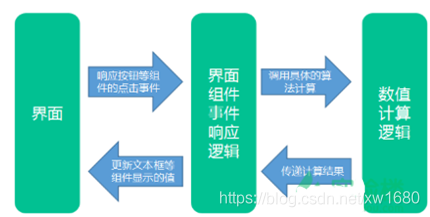
从结构上来说,一个简单的图形界面,需要由界面组件、组件的事件监听器(响应各类事件的逻辑)和具体的事件处理逻辑组成。界面实现的主要工作是创建各个界面组件对象,对其进行初始化,以及控制各组件之间的层次关系和布局。
3. 示例效果
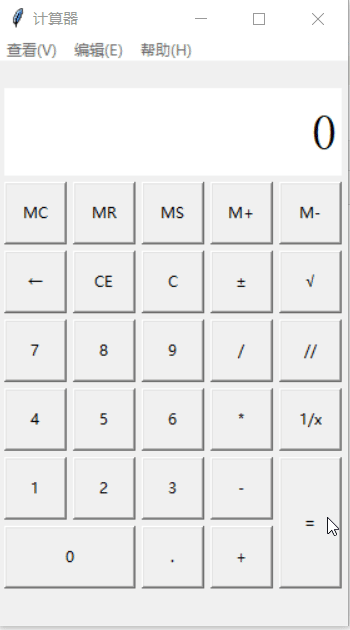
4. 示例源码
- import tkinter
- import math
- import tkinter.messagebox
-
-
- class Calculator(object):
- # 界面布局方法
- def __init__(self):
- # 创建主界面,并且保存到成员属性中
- self.root = tkinter.Tk()
- self.root.minsize(280, 450)
- self.root.maxsize(280, 470)
- self.root.title('计算器')
- # 设置显式面板的变量
- self.result = tkinter.StringVar()
- self.result.set(0)
- # 设置一个全局变量 运算数字和f符号的列表
- self.lists = []
- # 添加一个用于判断是否按下运算符号的标志
- self.ispresssign = False
- # 界面布局
- self.menus()
- self.layout()
- self.root.mainloop()
-
- # 计算器菜单界面摆放
-
- def menus(self):
- # 添加菜单
- # 创建总菜单
- allmenu = tkinter.Menu(self.root)
- # 添加子菜单
- filemenu = tkinter.Menu(allmenu, tearoff=0)
- # 添加选项卡
- filemenu.add_command(
- label='标准型(T) Alt+1', command=self.myfunc)
- filemenu.add_command(
- label='科学型(S) Alt+2', command=self.myfunc)
- filemenu.add_command(
- label='程序员(P) Alt+3', command=self.myfunc)
- filemenu.add_command(label='统计信息(A) Alt+4', command=self.myfunc)
- # 添加分割线
- filemenu.add_separator()
- # 添加选项卡
- filemenu.add_command(label='历史记录(Y) Ctrl+H', command=self.myfunc)
- filemenu.add_command(label='数字分组(I)', command=self.myfunc)
- # 添加分割线
- filemenu.add_separator()
- # 添加选项卡
- filemenu.add_command(
- label='基本(B) Ctrl+F4', command=self.myfunc)
- filemenu.add_command(label='单位转换(U) Ctrl+U', command=self.myfunc)
- filemenu.add_command(label='日期计算(D) Ctrl+E', command=self.myfunc)
- menu1 = tkinter.Menu(filemenu, tearoff=0)
- menu1.add_command(label='抵押(M)', command=self.myfunc)
- menu1.add_command(label='汽车租赁(V)', command=self.myfunc)
- menu1.add_command(label='油耗(mpg)(F)', command=self.myfunc)
- menu1.add_command(label='油耗(l/100km)(U)', command=self.myfunc)
- filemenu.add_cascade(label='工作表(W)', menu=menu1)
- allmenu.add_cascade(label='查看(V)', menu=filemenu)
-
- # 添加子菜单2
- editmenu = tkinter.Menu(allmenu, tearoff=0)
- # 添加选项卡
- editmenu.add_command(label='复制(C) Ctrl+C', command=self.myfunc)
- editmenu.add_command(label='粘贴(V) Ctrl+V', command=self.myfunc)
- # 添加分割线
- editmenu.add_separator()
- # 添加选项卡
- menu2 = tkinter.Menu(filemenu, tearoff=0)
- menu2.add_command(label='复制历史记录(I)', command=self.myfunc)
- menu2.add_command(
- label='编辑(E) F2', command=self.myfunc)
- menu2.add_command(label='取消编辑(N) Esc', command=self.myfunc)
- menu2.add_command(label='清除(L) Ctrl+Shift+D', command=self.myfunc)
- editmenu.add_cascade(label='历史记录(H)', menu=menu2)
- allmenu.add_cascade(label='编辑(E)', menu=editmenu)
-
- # 添加子菜单3
- helpmenu = tkinter.Menu(allmenu, tearoff=0)
- # 添加选项卡
- helpmenu.add_command(label='查看帮助(V) F1', command=self.myfunc)
- # 添加分割线
- helpmenu.add_separator()
- # 添加选项卡
- helpmenu.add_command(label='关于计算器(A)', command=self.myfunc)
- allmenu.add_cascade(label='帮助(H)', menu=helpmenu)
-
- self.root.config(menu=allmenu)
-
- # 计算器主界面摆放
-
- def layout(self):
- # 显示屏
- result = tkinter.StringVar()
- result.set(0)
- show_label = tkinter.Label(self.root, bd=3, bg='white', font=(
- '宋体', 30), anchor='e', textvariable=self.result)
- show_label.place(x=5, y=20, width=270, height=70)
- # 功能按钮MC
- button_mc = tkinter.Button(self.root, text='MC', command=self.wait)
- button_mc.place(x=5, y=95, width=50, height=50)
- # 功能按钮MR
- button_mr = tkinter.Button(self.root, text='MR', command=self.wait)
- button_mr.place(x=60, y=95, width=50, height=50)
- # 功能按钮MS
- button_ms = tkinter.Button(self.root, text='MS', command=self.wait)
- button_ms.place(x=115, y=95, width=50, height=50)
- # 功能按钮M+
- button_mjia = tkinter.Button(self.root, text='M+', command=self.wait)
- button_mjia.place(x=170, y=95, width=50, height=50)
- # 功能按钮M-
- button_mjian = tkinter.Button(self.root, text='M-', command=self.wait)
- button_mjian.place(x=225, y=95, width=50, height=50)
- # 功能按钮←
- button_zuo = tkinter.Button(self.root, text='←', command=self.dele_one)
- button_zuo.place(x=5, y=150, width=50, height=50)
- # 功能按钮CE
- button_ce = tkinter.Button(
- self.root, text='CE', command=lambda: self.result.set(0))
- button_ce.place(x=60, y=150, width=50, height=50)
- # 功能按钮C
- button_c = tkinter.Button(self.root, text='C', command=self.sweeppress)
- button_c.place(x=115, y=150, width=50, height=50)
- # 功能按钮±
- button_zf = tkinter.Button(self.root, text='±', command=self.zf)
- button_zf.place(x=170, y=150, width=50, height=50)
- # 功能按钮√
- button_kpf = tkinter.Button(self.root, text='√', command=self.kpf)
- button_kpf.place(x=225, y=150, width=50, height=50)
- # 数字按钮7
- button_7 = tkinter.Button(
- self.root, text='7', command=lambda: self.pressnum('7'))
- button_7.place(x=5, y=205, width=50, height=50)
- # 数字按钮8
- button_8 = tkinter.Button(
- self.root, text='8', command=lambda: self.pressnum('8'))
- button_8.place(x=60, y=205, width=50, height=50)
- # 数字按钮9
- button_9 = tkinter.Button(
- self.root, text='9', command=lambda: self.pressnum('9'))
- button_9.place(x=115, y=205, width=50, height=50)
- # 功能按钮/
- button_division = tkinter.Button(
- self.root, text='/', command=lambda: self.presscalculate('/'))
- button_division.place(x=170, y=205, width=50, height=50)
- # 功能按钮%
- button_remainder = tkinter.Button(
- self.root, text='//', command=lambda: self.presscalculate('//'))
- button_remainder.place(x=225, y=205, width=50, height=50)
- # 数字按钮4
- button_4 = tkinter.Button(
- self.root, text='4', command=lambda: self.pressnum('4'))
- button_4.place(x=5, y=260, width=50, height=50)
- # 数字按钮5
- button_5 = tkinter.Button(
- self.root, text='5', command=lambda: self.pressnum('5'))
- button_5.place(x=60, y=260, width=50, height=50)
- # 数字按钮6
- button_6 = tkinter.Button(
- self.root, text='6', command=lambda: self.pressnum('6'))
- button_6.place(x=115, y=260, width=50, height=50)
- # 功能按钮*
- button_multiplication = tkinter.Button(
- self.root, text='*', command=lambda: self.presscalculate('*'))
- button_multiplication.place(x=170, y=260, width=50, height=50)
- # 功能按钮1/x
- button_reciprocal = tkinter.Button(
- self.root, text='1/x', command=self.ds)
- button_reciprocal.place(x=225, y=260, width=50, height=50)
- # 数字按钮1
- button_1 = tkinter.Button(
- self.root, text='1', command=lambda: self.pressnum('1'))
- button_1.place(x=5, y=315, width=50, height=50)
- # 数字按钮2
- button_2 = tkinter.Button(
- self.root, text='2', command=lambda: self.pressnum('2'))
- button_2.place(x=60, y=315, width=50, height=50)
- # 数字按钮3
- button_3 = tkinter.Button(
- self.root, text='3', command=lambda: self.pressnum('3'))
- button_3.place(x=115, y=315, width=50, height=50)
- # 功能按钮-
- button_subtraction = tkinter.Button(
- self.root, text='-', command=lambda: self.presscalculate('-'))
- button_subtraction.place(x=170, y=315, width=50, height=50)
- # 功能按钮=
- button_equal = tkinter.Button(
- self.root, text='=', command=lambda: self.pressequal())
- button_equal.place(x=225, y=315, width=50, height=105)
- # 数字按钮0
- button_0 = tkinter.Button(
- self.root, text='0', command=lambda: self.pressnum('0'))
- button_0.place(x=5, y=370, width=105, height=50)
- # 功能按钮.
- button_point = tkinter.Button(
- self.root, text='.', command=lambda: self.pressnum('.'))
- button_point.place(x=115, y=370, width=50, height=50)
- # 功能按钮+
- button_plus = tkinter.Button(
- self.root, text='+', command=lambda: self.presscalculate('+'))
- button_plus.place(x=170, y=370, width=50, height=50)
-
- # 计算器菜单功能
-
- def myfunc(self):
- tkinter.messagebox.showinfo('', '预留接口,学成之后,你是不是有冲动添加该功能.')
-
- # 数字方法
- def pressnum(self, num):
- # 全局化变量
- # 判断是否按下了运算符号
- if self.ispresssign == False:
- pass
- else:
- self.result.set(0)
- # 重置运算符号的状态
- self.ispresssign = False
- if num == '.':
- num = '0.'
- # 获取面板中的原有数字
- oldnum = self.result.get()
- # 判断界面数字是否为0
- if oldnum == '0':
- self.result.set(num)
- else:
- # 连接上新按下的数字
- newnum = oldnum + num
-
- # 将按下的数字写到面板中
- self.result.set(newnum)
-
- # 运算函数
- def presscalculate(self, sign):
- # 保存已经按下的数字和运算符号
- # 获取界面数字
- num = self.result.get()
- self.lists.append(num)
- # 保存按下的操作符号
- self.lists.append(sign)
- # 设置运算符号为按下状态
- self.ispresssign = True
-
- # 获取运算结果
-
- def pressequal(self):
- # 获取所有的列表中的内容(之前的数字和操作)
- # 获取当前界面上的数字
- curnum = self.result.get()
- # 将当前界面的数字存入列表
- self.lists.append(curnum)
- # 将列表转化为字符串
- calculatestr = ''.join(self.lists)
- # 使用eval执行字符串中的运算即可
- endnum = eval(calculatestr)
- # 将运算结果显示在界面中
- self.result.set(str(endnum)[:10])
- if self.lists != 0:
- self.ispresssign = True
- # 清空运算列表
- self.lists.clear()
-
- # 暂未开发说明
-
- def wait(self):
- tkinter.messagebox.showinfo('', '更新中......')
-
- # ←按键功能
-
- def dele_one(self):
- if self.result.get() == '' or self.result.get() == '0':
- self.result.set('0')
- return
- else:
- num = len(self.result.get())
- if num > 1:
- strnum = self.result.get()
- strnum = strnum[0:num - 1]
- self.result.set(strnum)
- else:
- self.result.set('0')
-
- # ±按键功能
-
- def zf(self):
- strnum = self.result.get()
- if strnum[0] == '-':
- self.result.set(strnum[1:])
- elif strnum[0] != '-' and strnum != '0':
- self.result.set('-' + strnum)
-
- # 1/x按键功能
-
- def ds(self):
- dsnum = 1 / int(self.result.get())
- self.result.set(str(dsnum)[:10])
- if self.lists != 0:
- self.ispresssign = True
- # 清空运算列表
- self.lists.clear()
-
- # C按键功能
-
- def sweeppress(self):
- self.lists.clear()
- self.result.set(0)
-
- # √按键功能
-
- def kpf(self):
- strnum = float(self.result.get())
- endnum = math.sqrt(strnum)
- if str(endnum)[-1] == '0':
- self.result.set(str(endnum)[:-2])
- else:
- self.result.set(str(endnum)[:10])
- if self.lists != 0:
- self.ispresssign = True
- # 清空运算列表
- self.lists.clear()
-
-
- # 实例化对象
- my_calculator = Calculator()

2、记事本
1. 案例介绍
tkinter 是 Python下面向 tk 的图形界面接口库,可以方便地进行图形界面设计和交互操作编程。tkinter 的优点是简单易用、与 Python 的结合度好。tkinter 在 Python 3.x 下默认集成,不需要额外的安装操作;不足之处为缺少合适的可视化界面设计工具,需要通过代码来完成窗口设计和元素布局。本例采用的 Python 版本为 3.8,如果想在 python 2.x下使用 tkinter,请先进行安装。需要注意的是,不同 Python 版本下的 tkinter 使用方式可能略有不同,建议采用 Python3.x 版本。本例难度为中级,适合具有 Python 基础和 Tkinter 组件编程知识的用户学习。
2. 示例效果
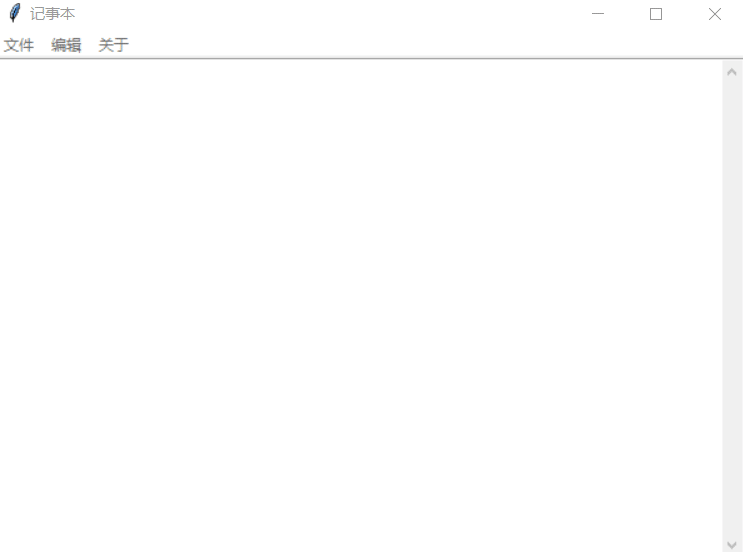
3. 示例源码
- from tkinter import *
- from tkinter.filedialog import *
- from tkinter.messagebox import *
- import os
-
- filename = ""
-
-
- def author():
- showinfo(title="作者", message="Python")
-
-
- def power():
- showinfo(title="版权信息", message="课堂练习")
-
-
- def mynew():
- global top, filename, textPad
- top.title("未命名文件")
- filename = None
- textPad.delete(1.0, END)
-
-
- def myopen():
- global filename
- filename = askopenfilename(defaultextension=".txt")
- if filename == "":
- filename = None
- else:
- top.title("记事本" + os.path.basename(filename))
- textPad.delete(1.0, END)
- f = open(filename, 'r')
- textPad.insert(1.0, f.read())
- f.close()
-
-
- def mysave():
- global filename
- try:
- f = open(filename, 'w')
- msg = textPad.get(1.0, 'end')
- f.write(msg)
- f.close()
- except:
- mysaveas()
-
-
- def mysaveas():
- global filename
- f = asksaveasfilename(initialfile="未命名.txt", defaultextension=".txt")
- filename = f
- fh = open(f, 'w')
- msg = textPad.get(1.0, END)
- fh.write(msg)
- fh.close()
- top.title("记事本 " + os.path.basename(f))
-
-
- def cut():
- global textPad
- textPad.event_generate("<<Cut>>")
-
-
- def copy():
- global textPad
- textPad.event_generate("<<Copy>>")
-
-
- def paste():
- global textPad
- textPad.event_generate("<<Paste>>")
-
-
- def undo():
- global textPad
- textPad.event_generate("<<Undo>>")
-
-
- def redo():
- global textPad
- textPad.event_generate("<<Redo>>")
-
-
- def select_all():
- global textPad
- # textPad.event_generate("<<Cut>>")
- textPad.tag_add("sel", "1.0", "end")
-
-
- def find():
- t = Toplevel(top)
- t.title("查找")
- t.geometry("260x60+200+250")
- t.transient(top)
- Label(t, text="查找:").grid(row=0, column=0, sticky="e")
- v = StringVar()
- e = Entry(t, width=20, textvariable=v)
- e.grid(row=0, column=1, padx=2, pady=2, sticky="we")
- e.focus_set()
- c = IntVar()
- Checkbutton(t, text="不区分大小写", variable=c).grid(row=1, column=1, sticky='e')
- Button(t, text="查找所有", command=lambda: search(v.get(), c.get(),
- textPad, t, e)).grid(row=0, column=2, sticky="e" + "w", padx=2,
- pady=2)
-
- def close_search():
- textPad.tag_remove("match", "1.0", END)
- t.destroy()
-
- t.protocol("WM_DELETE_WINDOW", close_search)
-
-
- def mypopup(event):
- # global editmenu
- editmenu.tk_popup(event.x_root, event.y_root)
-
-
- def search(needle, cssnstv, textPad, t, e):
- textPad.tag_remove("match", "1.0", END)
- count = 0
- if needle:
- pos = "1.0"
- while True:
- pos = textPad.search(needle, pos, nocase=cssnstv, stopindex=END)
- if not pos:
- break
- lastpos = pos + str(len(needle))
- textPad.tag_add("match", pos, lastpos)
- count += 1
- pos = lastpos
- textPad.tag_config('match', fg='yellow', bg="green")
- e.focus_set()
- t.title(str(count) + "个被匹配")
-
-
- top = Tk()
- top.title("记事本")
- top.geometry("600x400+100+50")
-
- menubar = Menu(top)
-
- # 文件功能
- filemenu = Menu(top)
- filemenu.add_command(label="新建", accelerator="Ctrl+N", command=mynew)
- filemenu.add_command(label="打开", accelerator="Ctrl+O", command=myopen)
- filemenu.add_command(label="保存", accelerator="Ctrl+S", command=mysave)
- filemenu.add_command(label="另存为", accelerator="Ctrl+shift+s", command=mysaveas)
- menubar.add_cascade(label="文件", menu=filemenu)
-
- # 编辑功能
- editmenu = Menu(top)
- editmenu.add_command(label="撤销", accelerator="Ctrl+Z", command=undo)
- editmenu.add_command(label="重做", accelerator="Ctrl+Y", command=redo)
- editmenu.add_separator()
- editmenu.add_command(label="剪切", accelerator="Ctrl+X", command=cut)
- editmenu.add_command(label="复制", accelerator="Ctrl+C", command=copy)
- editmenu.add_command(label="粘贴", accelerator="Ctrl+V", command=paste)
- editmenu.add_separator()
- editmenu.add_command(label="查找", accelerator="Ctrl+F", command=find)
- editmenu.add_command(label="全选", accelerator="Ctrl+A", command=select_all)
- menubar.add_cascade(label="编辑", menu=editmenu)
-
- # 关于 功能
- aboutmenu = Menu(top)
- aboutmenu.add_command(label="作者", command=author)
- aboutmenu.add_command(label="版权", command=power)
- menubar.add_cascade(label="关于", menu=aboutmenu)
-
- top['menu'] = menubar
-
- # shortcutbar = Frame(top, height=25, bg='light sea green')
- # shortcutbar.pack(expand=NO, fill=X)
- # Inlabe = Label(top, width=2, bg='antique white')
- # Inlabe.pack(side=LEFT, anchor='nw', fill=Y)
-
- textPad = Text(top, undo=True)
- textPad.pack(expand=YES, fill=BOTH)
- scroll = Scrollbar(textPad)
- textPad.config(yscrollcommand=scroll.set)
- scroll.config(command=textPad.yview)
- scroll.pack(side=RIGHT, fill=Y)
-
- # 热键绑定
- textPad.bind("<Control-N>", mynew)
- textPad.bind("<Control-n>", mynew)
- textPad.bind("<Control-O>", myopen)
- textPad.bind("<Control-o>", myopen)
- textPad.bind("<Control-S>", mysave)
- textPad.bind("<Control-s>", mysave)
- textPad.bind("<Control-A>", select_all)
- textPad.bind("<Control-a>", select_all)
- textPad.bind("<Control-F>", find)
- textPad.bind("<Control-f>", find)
-
- textPad.bind("<Button-3>", mypopup)
- top.mainloop()

3、登录和注册
1. 案例介绍
本例设计一个用户登录和注册模块,使用 Tkinter 框架构建界面,主要用到画布、文本框、按钮等组件。涉及知识点:Python Tkinter 界面编程、pickle 数据存储。本例实现了基本的用户登录和注册互动界面,并提供用户信息存储和验证。pickle 是 python 语言的一个标准模块,安装 python 后已包含 pickle 库,不需要单独再安装。pickle 模块实现了基本的数据序列化和反序列化。通过 pickle 模块的序列化操作能够将程序中运行的对象信息保存到文件中去,永久存储;通过 pickle 模块的反序列化操作,能够从文件中创建上一次程序保存的对象。本例难度为中级,适合具有 Python 基础和 Tkinter 组件编程知识的用户学习。
2. 示例效果
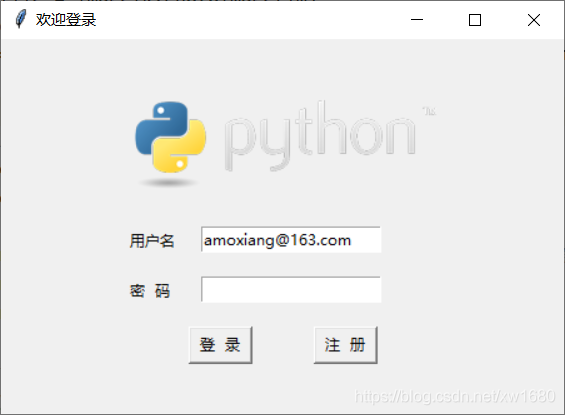
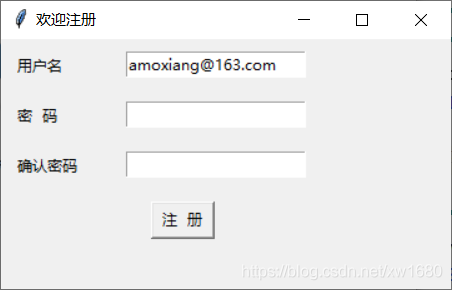
3. 示例源码
- import tkinter as tk
- import pickle
- import tkinter.messagebox
- from PIL import Image, ImageTk
-
- # 设置窗口---最开始的母体窗口
- window = tk.Tk() # 建立一个窗口
- window.title('欢迎登录')
- window.geometry('450x300') # 窗口大小为300x200
-
- # 画布
- canvas = tk.Canvas(window, height=200, width=900)
- # 加载图片
- im = Image.open("images/01.png")
- image_file = ImageTk.PhotoImage(im)
- # image_file = tk.PhotoImage(file='images/01.gif')
- image = canvas.create_image(100, 40, anchor='nw', image=image_file)
- canvas.pack(side='top')
-
- # 两个文字标签,用户名和密码两个部分
- tk.Label(window, text='用户名').place(x=100, y=150)
- tk.Label(window, text='密 码').place(x=100, y=190)
-
- var_usr_name = tk.StringVar() # 讲文本框的内容,定义为字符串类型
- var_usr_name.set('amoxiang@163.com') # 设置默认值
- var_usr_pwd = tk.StringVar()
-
- # 第一个输入框-用来输入用户名的。
- # textvariable 获取文本框的内容
- entry_usr_name = tk.Entry(window, textvariable=var_usr_name)
- entry_usr_name.place(x=160, y=150)
- # 第二个输入框-用来输入密码的。
- entry_usr_pwd = tk.Entry(window, textvariable=var_usr_pwd, show='*')
- entry_usr_pwd.place(x=160, y=190)
-
-
- def usr_login():
- usr_name = var_usr_name.get()
- usr_pwd = var_usr_pwd.get()
- try:
- with open('usrs_info.pickle', 'rb') as usr_file:
- usrs_info = pickle.load(usr_file)
- except FileNotFoundError:
- with open('usrs_info.pickle', 'wb') as usr_file:
- usrs_info = {'admin': 'admin'}
- pickle.dump(usrs_info, usr_file)
-
- if usr_name in usrs_info:
- if usr_pwd == usrs_info[usr_name]:
- tk.messagebox.showinfo(
- title='欢迎光临', message=usr_name + ':请进入个人首页,查看最新资讯')
- else:
- tk.messagebox.showinfo(message='错误提示:密码不对,请重试')
- else:
- is_sign_up = tk.messagebox.askyesno('提示', '你还没有注册,请先注册')
- print(is_sign_up)
- if is_sign_up:
- usr_sign_up()
-
-
- # 注册按钮
- def usr_sign_up():
- def sign_to_Mofan_Python():
- np = new_pwd.get()
- npf = new_pwd_confirm.get()
- nn = new_name.get()
- # 上面是获取数据,下面是查看一下是否重复注册过
- with open('usrs_info.pickle', 'rb') as usr_file:
- exist_usr_info = pickle.load(usr_file)
- if np != npf:
- tk.messagebox.showerror('错误提示', '密码和确认密码必须一样')
- elif nn in exist_usr_info:
- tk.messagebox.showerror('错误提示', '用户名早就注册了!')
- else:
- exist_usr_info[nn] = np
- with open('usrs_info.pickle', 'wb') as usr_file:
- pickle.dump(exist_usr_info, usr_file)
- tk.messagebox.showinfo('欢迎', '你已经成功注册了')
- window_sign_up.destroy()
-
- # 点击注册之后,会弹出这个窗口界面。
- window_sign_up = tk.Toplevel(window)
- window_sign_up.title('欢迎注册')
- window_sign_up.geometry('360x200') # 中间是x,而不是*号
-
- # 用户名框--这里输入用户名框。
- new_name = tk.StringVar()
- new_name.set('amoxiang@163.com') # 设置的是默认值
- tk.Label(window_sign_up, text='用户名').place(x=10, y=10)
- entry_new_name = tk.Entry(window_sign_up, textvariable=new_name)
- entry_new_name.place(x=100, y=10)
-
- # 新密码框--这里输入注册时候的密码
- new_pwd = tk.StringVar()
- tk.Label(window_sign_up, text='密 码').place(x=10, y=50)
- entry_usr_pwd = tk.Entry(window_sign_up, textvariable=new_pwd, show='*')
- entry_usr_pwd.place(x=100, y=50)
-
- # 密码确认框
- new_pwd_confirm = tk.StringVar()
- tk.Label(window_sign_up, text='确认密码').place(x=10, y=90)
- entry_usr_pwd_confirm = tk.Entry(
- window_sign_up, textvariable=new_pwd_confirm, show='*')
- entry_usr_pwd_confirm.place(x=100, y=90)
-
- btn_confirm_sign_up = tk.Button(
- window_sign_up, text=' 注 册 ', command=sign_to_Mofan_Python)
- btn_confirm_sign_up.place(x=120, y=130)
-
-
- # 创建注册和登录按钮
- btn_login = tk.Button(window, text=' 登 录 ', command=usr_login)
- btn_login.place(x=150, y=230) # 用place来处理按钮的位置信息。
- btn_sign_up = tk.Button(window, text=' 注 册 ', command=usr_sign_up)
- btn_sign_up.place(x=250, y=230)
-
- window.mainloop()

游戏开发
1、2048
1. 游戏简介
2048 是一款比较流行的数字游戏。游戏规则:每次可按上、下、左、右方向键滑动数字,每滑动一次,所有数字都会往滑动方向靠拢,同时在空白位置随机出现一个数字,相同数字在靠拢时会相加。不断叠加最终拼出 2048 这个数字算成功。2048 最早于 2014年3月20日发行。原版 2048 首先在 GitHub 上发布,原作者是 Gabriele Cirulli,后被移植到各个平台。本例难度为初级,适合具有 Python 基础和 Pygame 编程知识的用户学习。
2. 设计原理
这个游戏的本质是二维列表,就以 4*4 的二位列表来分析关键的逻辑以及实现。二维列表如下图:
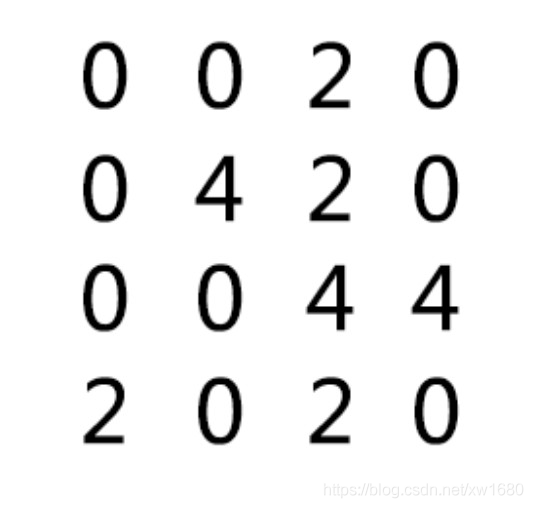
所有的操作都是对这个二维列表的数据的操作。分为上下左右四个方向。先说向左的方向(如图)。

向左操作的结果如下图;当向左的方向是,所有的数据沿着水平方向向左跑。
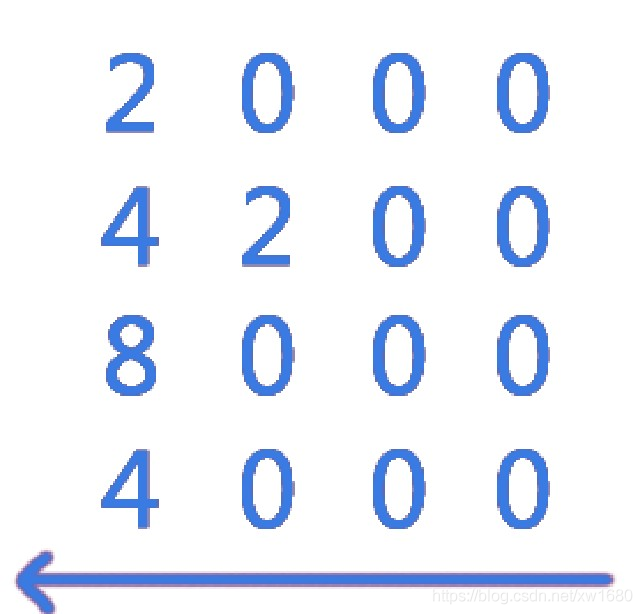
水平说明操作的是二维列表的一行,而垂直操作的则是二位列表的一列。这样就可以将二维列表的操作变成遍历后对一维列表的操作。向左说明数据的优先考虑的位置是从左开始的。这样就确定了一维列表的遍历开始的位置。上面第 2 个图共四行,每一个行都能得到一个列表。
- list1:[0,0,2,0]
- list2:[0,4,2,0]
- list3:[0,0,4,4]
- list4:[2,0,2,0]
这样一来向左的方向就变成。从上到下获得每一行的列表,方向向左。参数(row,left)。
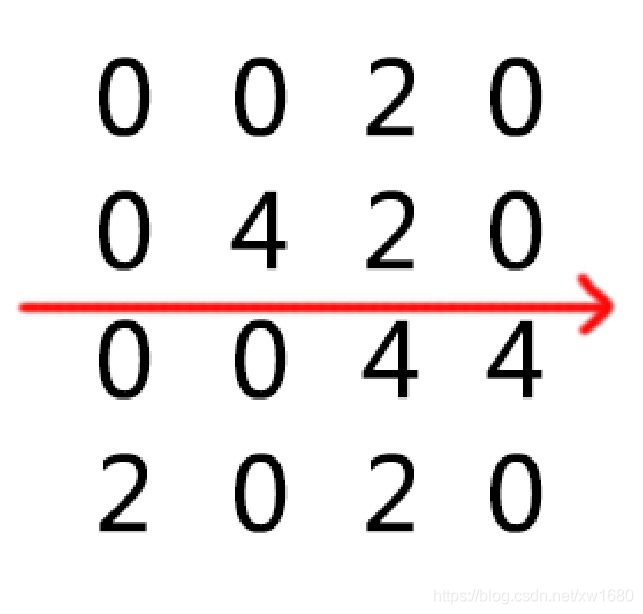
其他的三个方向在开始的时候记住是怎样获得以为列表的,等操作完才放回去这样就能实现了。
**3. 示例效果 **
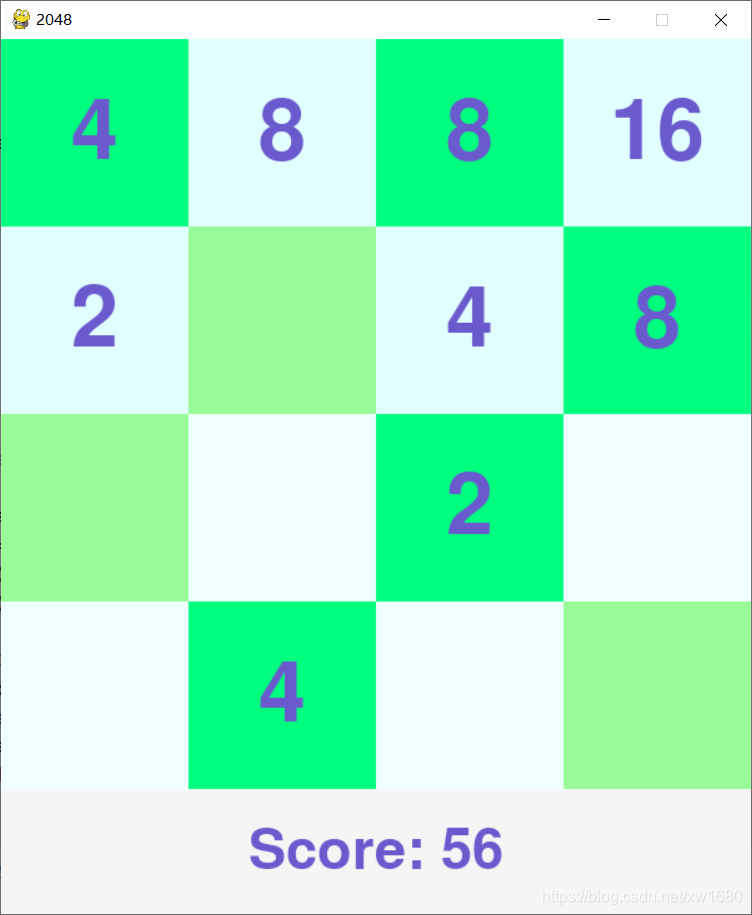
4. 示例源码
- import random
- import sys
- import pygame
- from pygame.locals import *
-
- PIXEL = 150
- SCORE_PIXEL = 100
- SIZE = 4
-
-
- # 地图的类
-
-
- class Map:
- def __init__(self, size):
- self.size = size
- self.score = 0
- self.map = [[0 for i in range(size)] for i in range(size)]
- self.add()
- self.add()
-
- # 新增2或4,有1/4概率产生4
- def add(self):
- while True:
- p = random.randint(0, self.size * self.size - 1)
- if self.map[int(p / self.size)][int(p % self.size)] == 0:
- x = random.randint(0, 3) > 0 and 2 or 4
- self.map[int(p / self.size)][int(p % self.size)] = x
- self.score += x
- break
-
- # 地图向左靠拢,其他方向的靠拢可以通过适当旋转实现,返回地图是否更新
- def adjust(self):
- changed = False
- for a in self.map:
- b = []
- last = 0
- for v in a:
- if v != 0:
- if v == last:
- b.append(b.pop() << 1)
- last = 0
- else:
- b.append(v)
- last = v
- b += [0] * (self.size - len(b))
- for i in range(self.size):
- if a[i] != b[i]:
- changed = True
- a[:] = b
- return changed
-
- # 逆时针旋转地图90度
- def rotate90(self):
- self.map = [[self.map[c][r]
- for c in range(self.size)] for r in reversed(range(self.size))]
-
- # 判断游戏结束
- def over(self):
- for r in range(self.size):
- for c in range(self.size):
- if self.map[r][c] == 0:
- return False
- for r in range(self.size):
- for c in range(self.size - 1):
- if self.map[r][c] == self.map[r][c + 1]:
- return False
- for r in range(self.size - 1):
- for c in range(self.size):
- if self.map[r][c] == self.map[r + 1][c]:
- return False
- return True
-
- def moveUp(self):
- self.rotate90()
- if self.adjust():
- self.add()
- self.rotate90()
- self.rotate90()
- self.rotate90()
-
- def moveRight(self):
- self.rotate90()
- self.rotate90()
- if self.adjust():
- self.add()
- self.rotate90()
- self.rotate90()
-
- def moveDown(self):
- self.rotate90()
- self.rotate90()
- self.rotate90()
- if self.adjust():
- self.add()
- self.rotate90()
-
- def moveLeft(self):
- if self.adjust():
- self.add()
-
-
- # 更新屏幕
-
-
- def show(map):
- for i in range(SIZE):
- for j in range(SIZE):
- # 背景颜色块
- screen.blit(map.map[i][j] == 0 and block[(i + j) % 2]
- or block[2 + (i + j) % 2], (PIXEL * j, PIXEL * i))
- # 数值显示
- if map.map[i][j] != 0:
- map_text = map_font.render(
- str(map.map[i][j]), True, (106, 90, 205))
- text_rect = map_text.get_rect()
- text_rect.center = (PIXEL * j + PIXEL / 2,
- PIXEL * i + PIXEL / 2)
- screen.blit(map_text, text_rect)
- # 分数显示
- screen.blit(score_block, (0, PIXEL * SIZE))
- score_text = score_font.render((map.over(
- ) and "Game over with score " or "Score: ") + str(map.score), True, (106, 90, 205))
- score_rect = score_text.get_rect()
- score_rect.center = (PIXEL * SIZE / 2, PIXEL * SIZE + SCORE_PIXEL / 2)
- screen.blit(score_text, score_rect)
- pygame.display.update()
-
-
- map = Map(SIZE)
- pygame.init()
- screen = pygame.display.set_mode((PIXEL * SIZE, PIXEL * SIZE + SCORE_PIXEL))
- pygame.display.set_caption("2048")
- block = [pygame.Surface((PIXEL, PIXEL)) for i in range(4)]
- # 设置颜色
- block[0].fill((152, 251, 152))
- block[1].fill((240, 255, 255))
- block[2].fill((0, 255, 127))
- block[3].fill((225, 255, 255))
- score_block = pygame.Surface((PIXEL * SIZE, SCORE_PIXEL))
- score_block.fill((245, 245, 245))
- # 设置字体
- map_font = pygame.font.Font(None, int(PIXEL * 2 / 3))
- score_font = pygame.font.Font(None, int(SCORE_PIXEL * 2 / 3))
- clock = pygame.time.Clock()
- show(map)
-
- while not map.over():
- # 12为实验参数
- clock.tick(12)
- for event in pygame.event.get():
- if event.type == QUIT:
- sys.exit()
- # 接收玩家操作
- pressed_keys = pygame.key.get_pressed()
- if pressed_keys[K_w] or pressed_keys[K_UP]:
- map.moveUp()
- elif pressed_keys[K_s] or pressed_keys[K_DOWN]:
- map.moveDown()
- elif pressed_keys[K_a] or pressed_keys[K_LEFT]:
- map.moveLeft()
- elif pressed_keys[K_d] or pressed_keys[K_RIGHT]:
- map.moveRight()
- show(map)
-
- # 游戏结束
- pygame.time.delay(3000)

2、贪吃蛇
1. 案例介绍
贪吃蛇是一款经典的益智游戏,简单又耐玩。该游戏通过控制蛇头方向吃蛋,从而使得蛇变得越来越长。通过上下左右方向键控制蛇的方向,寻找吃的东西,每吃一口就能得到一定的积分,而且蛇的身子会越吃越长,身子越长玩的难度就越大,不能碰墙,不能咬到自己的身体,更不能咬自己的尾巴,等到了一定的分数,就能过关,然后继续玩下一关。本例难度为中级,适合具有 Python 基础和 Pygame 编程知识的用户学习。
2. 设计要点
游戏是基于 PyGame 框架制作的,程序核心逻辑如下:游戏界面分辨率是 640*480,蛇和食物都是由 1 个或多个 20*20 像素的正方形块儿(为了方便,下文用点表示 20*20 像素的正方形块儿) 组成,这样共有 32*24 个点,使用 pygame.draw.rect 来绘制每一个点;初始化时蛇的长度是 3,食物是 1 个点,蛇初始的移动的方向是右,用一个数组代表蛇,数组的每个元素是蛇每个点的坐标,因此数组的第一个坐标是蛇尾,最后一个坐标是蛇头;游戏开始后,根据蛇的当前移动方向,将蛇运动方向的前方的那个点 append 到蛇数组的末位,再把蛇尾去掉,蛇的坐标数组就相当于往前挪了一位;如果蛇吃到了食物,即蛇头的坐标等于食物的坐标,那么在第 2 点中蛇尾就不用去掉,就产生了蛇长度增加的效果;食物被吃掉后,随机在空的位置(不能与蛇的身体重合) 再生成一个;通过 PyGame 的 event 监控按键,改变蛇的方向,例如当蛇向右时,下一次改变方向只能向上或者向下;当蛇撞上自身或墙壁,游戏结束,蛇头装上自身,那么蛇坐标数组里就有和舌头坐标重复的数据,撞上墙壁则是蛇头坐标超过了边界,都很好判断;其他细节:做了个开始的欢迎界面;食物的颜色随机生成;吃到实物的时候有声音提示等。
3. 示例效果
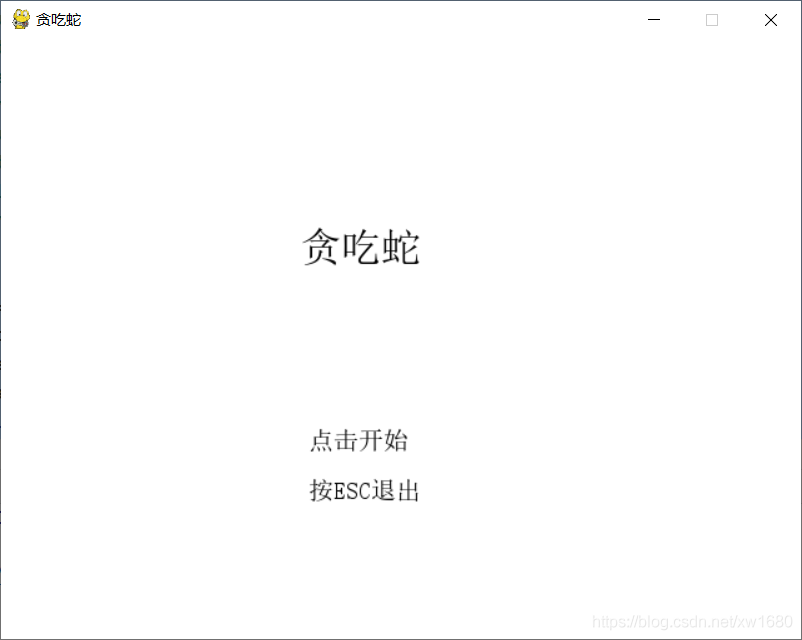
4. 示例源码
- import pygame
- from os import path
- from sys import exit
- from time import sleep
- from random import choice
- from itertools import product
- from pygame.locals import QUIT, KEYDOWN
-
-
- def direction_check(moving_direction, change_direction):
- directions = [['up', 'down'], ['left', 'right']]
- if moving_direction in directions[0] and change_direction in directions[1]:
- return change_direction
- elif moving_direction in directions[1] and change_direction in directions[0]:
- return change_direction
- return moving_direction
-
-
- class Snake:
- colors = list(product([0, 64, 128, 192, 255], repeat=3))[1:-1]
-
- def __init__(self):
- self.map = {(x, y): 0 for x in range(32) for y in range(24)}
- self.body = [[100, 100], [120, 100], [140, 100]]
- self.head = [140, 100]
- self.food = []
- self.food_color = []
- self.moving_direction = 'right'
- self.speed = 4
- self.generate_food()
- self.game_started = False
-
- def check_game_status(self):
- if self.body.count(self.head) > 1:
- return True
- if self.head[0] < 0 or self.head[0] > 620 or self.head[1] < 0 or self.head[1] > 460:
- return True
- return False
-
- def move_head(self):
- moves = {
- 'right': (20, 0),
- 'up': (0, -20),
- 'down': (0, 20),
- 'left': (-20, 0)
- }
- step = moves[self.moving_direction]
- self.head[0] += step[0]
- self.head[1] += step[1]
-
- def generate_food(self):
- self.speed = len(
- self.body) // 16 if len(self.body) // 16 > 4 else self.speed
- for seg in self.body:
- x, y = seg
- self.map[x // 20, y // 20] = 1
- empty_pos = [pos for pos in self.map.keys() if not self.map[pos]]
- result = choice(empty_pos)
- self.food_color = list(choice(self.colors))
- self.food = [result[0] * 20, result[1] * 20]
-
-
- def main():
- key_direction_dict = {
- 119: 'up', # W
- 115: 'down', # S
- 97: 'left', # A
- 100: 'right', # D
- 273: 'up', # UP
- 274: 'down', # DOWN
- 276: 'left', # LEFT
- 275: 'right', # RIGHT
- }
-
- fps_clock = pygame.time.Clock()
- pygame.init()
- pygame.mixer.init()
- snake = Snake()
- sound = False
- if path.exists('eat.wav'):
- sound_wav = pygame.mixer.Sound("eat.wav")
- sound = True
- title_font = pygame.font.SysFont('simsunnsimsun', 32)
- welcome_words = title_font.render(
- '贪吃蛇', True, (0, 0, 0), (255, 255, 255))
- tips_font = pygame.font.SysFont('simsunnsimsun', 20)
- start_game_words = tips_font.render(
- '点击开始', True, (0, 0, 0), (255, 255, 255))
- close_game_words = tips_font.render(
- '按ESC退出', True, (0, 0, 0), (255, 255, 255))
- gameover_words = title_font.render(
- '游戏结束', True, (205, 92, 92), (255, 255, 255))
- win_words = title_font.render(
- '蛇很长了,你赢了!', True, (0, 0, 205), (255, 255, 255))
- screen = pygame.display.set_mode((640, 480), 0, 32)
- pygame.display.set_caption('贪吃蛇')
- new_direction = snake.moving_direction
- while 1:
- for event in pygame.event.get():
- if event.type == QUIT:
- exit()
- elif event.type == KEYDOWN:
- if event.key == 27:
- exit()
- if snake.game_started and event.key in key_direction_dict:
- direction = key_direction_dict[event.key]
- new_direction = direction_check(
- snake.moving_direction, direction)
- elif (not snake.game_started) and event.type == pygame.MOUSEBUTTONDOWN:
- x, y = pygame.mouse.get_pos()
- if 213 <= x <= 422 and 304 <= y <= 342:
- snake.game_started = True
- screen.fill((255, 255, 255))
- if snake.game_started:
- snake.moving_direction = new_direction # 在这里赋值,而不是在event事件的循环中赋值,避免按键太快
- snake.move_head()
- snake.body.append(snake.head[:])
- if snake.head == snake.food:
- if sound:
- sound_wav.play()
- snake.generate_food()
- else:
- snake.body.pop(0)
- for seg in snake.body:
- pygame.draw.rect(screen, [0, 0, 0], [
- seg[0], seg[1], 20, 20], 0)
- pygame.draw.rect(screen, snake.food_color, [
- snake.food[0], snake.food[1], 20, 20], 0)
- if snake.check_game_status():
- screen.blit(gameover_words, (241, 310))
- pygame.display.update()
- snake = Snake()
- new_direction = snake.moving_direction
- sleep(3)
- elif len(snake.body) == 512:
- screen.blit(win_words, (33, 210))
- pygame.display.update()
- snake = Snake()
- new_direction = snake.moving_direction
- sleep(3)
- else:
- screen.blit(welcome_words, (240, 150))
- screen.blit(start_game_words, (246, 310))
- screen.blit(close_game_words, (246, 350))
- pygame.display.update()
- fps_clock.tick(snake.speed)
-
-
- if __name__ == '__main__':
- main()

3、俄罗斯方块
1. 案例介绍
俄罗斯方块是由 4 个小方块组成不同形状的板块,随机从屏幕上方落下,按方向键调整板块的位置和方向,在底部拼出完整的一行或几行。这些完整的横条会消失,给新落下来的板块腾出空间,并获得分数奖励。没有被消除掉的方块不断堆积,一旦堆到顶端,便告输,游戏结束。本例难度为高级,适合具有 Python 进阶和 Pygame 编程技巧的用户学习。
2. 设计要点
边框――由 15*25 个空格组成,方块就落在这里面。盒子――组成方块的其中小方块,是组成方块的基本单元。方块――从边框顶掉下的东西,游戏者可以翻转和改变位置。每个方块由 4 个盒子组成。形状――不同类型的方块。这里形状的名字被叫做 T, S, Z ,J, L, I , O。如下图所示: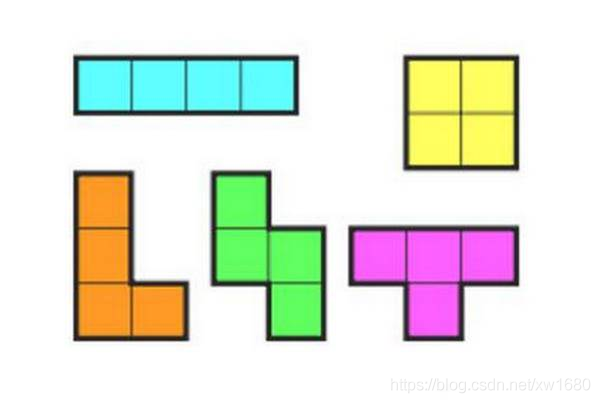
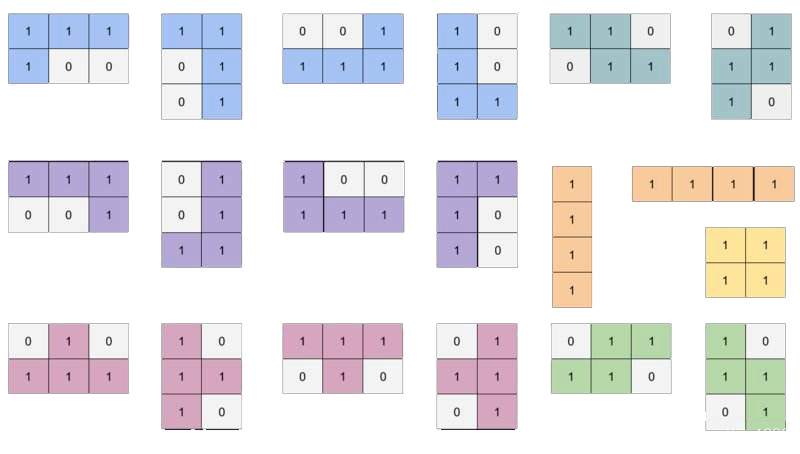
模版――用一个列表存放形状被翻转后的所有可能样式。全部存放在变量里,变量名字如 S or J。着陆――当一个方块到达边框的底部或接触到在其他的盒子话,就说这个方块着陆了。那样的话,另一个方块就会开始下落。
3. 示例效果
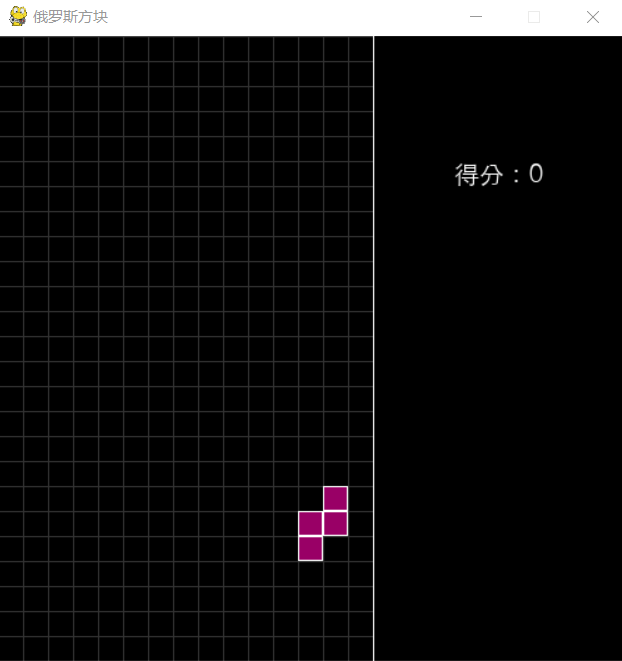
4. 示例源码
- import pygame
- import random
- import os
-
- pygame.init()
-
- GRID_WIDTH = 20
- GRID_NUM_WIDTH = 15
- GRID_NUM_HEIGHT = 25
- WIDTH, HEIGHT = GRID_WIDTH * GRID_NUM_WIDTH, GRID_WIDTH * GRID_NUM_HEIGHT
- SIDE_WIDTH = 200
- SCREEN_WIDTH = WIDTH + SIDE_WIDTH
- WHITE = (0xff, 0xff, 0xff)
- BLACK = (0, 0, 0)
- LINE_COLOR = (0x33, 0x33, 0x33)
-
- CUBE_COLORS = [
- (0xcc, 0x99, 0x99), (0xff, 0xff, 0x99), (0x66, 0x66, 0x99),
- (0x99, 0x00, 0x66), (0xff, 0xcc, 0x00), (0xcc, 0x00, 0x33),
- (0xff, 0x00, 0x33), (0x00, 0x66, 0x99), (0xff, 0xff, 0x33),
- (0x99, 0x00, 0x33), (0xcc, 0xff, 0x66), (0xff, 0x99, 0x00)
- ]
-
- screen = pygame.display.set_mode((SCREEN_WIDTH, HEIGHT))
- pygame.display.set_caption("俄罗斯方块")
- clock = pygame.time.Clock()
- FPS = 30
-
- score = 0
- level = 1
-
- screen_color_matrix = [[None] * GRID_NUM_WIDTH for i in range(GRID_NUM_HEIGHT)]
-
- # 设置游戏的根目录为当前文件夹
- base_folder = os.path.dirname(__file__)
-
-
- def show_text(surf, text, size, x, y, color=WHITE):
- font_name = os.path.join(base_folder, 'font/font.ttc')
- font = pygame.font.Font(font_name, size)
- text_surface = font.render(text, True, color)
- text_rect = text_surface.get_rect()
- text_rect.midtop = (x, y)
- surf.blit(text_surface, text_rect)
-
-
- class CubeShape(object):
- SHAPES = ['I', 'J', 'L', 'O', 'S', 'T', 'Z']
- I = [[(0, -1), (0, 0), (0, 1), (0, 2)],
- [(-1, 0), (0, 0), (1, 0), (2, 0)]]
- J = [[(-2, 0), (-1, 0), (0, 0), (0, -1)],
- [(-1, 0), (0, 0), (0, 1), (0, 2)],
- [(0, 1), (0, 0), (1, 0), (2, 0)],
- [(0, -2), (0, -1), (0, 0), (1, 0)]]
- L = [[(-2, 0), (-1, 0), (0, 0), (0, 1)],
- [(1, 0), (0, 0), (0, 1), (0, 2)],
- [(0, -1), (0, 0), (1, 0), (2, 0)],
- [(0, -2), (0, -1), (0, 0), (-1, 0)]]
- O = [[(0, 0), (0, 1), (1, 0), (1, 1)]]
- S = [[(-1, 0), (0, 0), (0, 1), (1, 1)],
- [(1, -1), (1, 0), (0, 0), (0, 1)]]
- T = [[(0, -1), (0, 0), (0, 1), (-1, 0)],
- [(-1, 0), (0, 0), (1, 0), (0, 1)],
- [(0, -1), (0, 0), (0, 1), (1, 0)],
- [(-1, 0), (0, 0), (1, 0), (0, -1)]]
- Z = [[(0, -1), (0, 0), (1, 0), (1, 1)],
- [(-1, 0), (0, 0), (0, -1), (1, -1)]]
- SHAPES_WITH_DIR = {
- 'I': I, 'J': J, 'L': L, 'O': O, 'S': S, 'T': T, 'Z': Z
- }
-
- def __init__(self):
- self.shape = self.SHAPES[random.randint(0, len(self.SHAPES) - 1)]
- # 骨牌所在的行列
- self.center = (2, GRID_NUM_WIDTH // 2)
- self.dir = random.randint(0, len(self.SHAPES_WITH_DIR[self.shape]) - 1)
- self.color = CUBE_COLORS[random.randint(0, len(CUBE_COLORS) - 1)]
-
- def get_all_gridpos(self, center=None):
- curr_shape = self.SHAPES_WITH_DIR[self.shape][self.dir]
- if center is None:
- center = [self.center[0], self.center[1]]
-
- return [(cube[0] + center[0], cube[1] + center[1])
- for cube in curr_shape]
-
- def conflict(self, center):
- for cube in self.get_all_gridpos(center):
- # 超出屏幕之外,说明不合法
- if cube[0] < 0 or cube[1] < 0 or cube[0] >= GRID_NUM_HEIGHT or \
- cube[1] >= GRID_NUM_WIDTH:
- return True
-
- # 不为None,说明之前已经有小方块存在了,也不合法
- if screen_color_matrix[cube[0]][cube[1]] is not None:
- return True
-
- return False
-
- def rotate(self):
- new_dir = self.dir + 1
- new_dir %= len(self.SHAPES_WITH_DIR[self.shape])
- old_dir = self.dir
- self.dir = new_dir
- if self.conflict(self.center):
- self.dir = old_dir
- return False
-
- def down(self):
- # import pdb; pdb.set_trace()
- center = (self.center[0] + 1, self.center[1])
- if self.conflict(center):
- return False
-
- self.center = center
- return True
-
- def left(self):
- center = (self.center[0], self.center[1] - 1)
- if self.conflict(center):
- return False
- self.center = center
- return True
-
- def right(self):
- center = (self.center[0], self.center[1] + 1)
- if self.conflict(center):
- return False
- self.center = center
- return True
-
- def draw(self):
- for cube in self.get_all_gridpos():
- pygame.draw.rect(screen, self.color,
- (cube[1] * GRID_WIDTH, cube[0] * GRID_WIDTH,
- GRID_WIDTH, GRID_WIDTH))
- pygame.draw.rect(screen, WHITE,
- (cube[1] * GRID_WIDTH, cube[0] * GRID_WIDTH,
- GRID_WIDTH, GRID_WIDTH),
- 1)
-
-
- def draw_grids():
- for i in range(GRID_NUM_WIDTH):
- pygame.draw.line(screen, LINE_COLOR,
- (i * GRID_WIDTH, 0), (i * GRID_WIDTH, HEIGHT))
-
- for i in range(GRID_NUM_HEIGHT):
- pygame.draw.line(screen, LINE_COLOR,
- (0, i * GRID_WIDTH), (WIDTH, i * GRID_WIDTH))
-
- pygame.draw.line(screen, WHITE,
- (GRID_WIDTH * GRID_NUM_WIDTH, 0),
- (GRID_WIDTH * GRID_NUM_WIDTH, GRID_WIDTH * GRID_NUM_HEIGHT))
-
-
- def draw_matrix():
- for i, row in zip(range(GRID_NUM_HEIGHT), screen_color_matrix):
- for j, color in zip(range(GRID_NUM_WIDTH), row):
- if color is not None:
- pygame.draw.rect(screen, color,
- (j * GRID_WIDTH, i * GRID_WIDTH,
- GRID_WIDTH, GRID_WIDTH))
- pygame.draw.rect(screen, WHITE,
- (j * GRID_WIDTH, i * GRID_WIDTH,
- GRID_WIDTH, GRID_WIDTH), 2)
-
-
- def draw_score():
- show_text(screen, u'得分:{}'.format(score), 20, WIDTH + SIDE_WIDTH // 2, 100)
-
-
- def remove_full_line():
- global screen_color_matrix
- global score
- global level
- new_matrix = [[None] * GRID_NUM_WIDTH for i in range(GRID_NUM_HEIGHT)]
- index = GRID_NUM_HEIGHT - 1
- n_full_line = 0
- for i in range(GRID_NUM_HEIGHT - 1, -1, -1):
- is_full = True
- for j in range(GRID_NUM_WIDTH):
- if screen_color_matrix[i][j] is None:
- is_full = False
- continue
- if not is_full:
- new_matrix[index] = screen_color_matrix[i]
- index -= 1
- else:
- n_full_line += 1
- score += n_full_line
- level = score // 20 + 1
- screen_color_matrix = new_matrix
-
-
- def show_welcome(screen):
- show_text(screen, u'俄罗斯方块', 30, WIDTH / 2, HEIGHT / 2)
- show_text(screen, u'按任意键开始游戏', 20, WIDTH / 2, HEIGHT / 2 + 50)
-
-
- running = True
- gameover = True
- counter = 0
- live_cube = None
- while running:
- clock.tick(FPS)
- for event in pygame.event.get():
- if event.type == pygame.QUIT:
- running = False
- elif event.type == pygame.KEYDOWN:
- if gameover:
- gameover = False
- live_cube = CubeShape()
- break
- if event.key == pygame.K_LEFT:
- live_cube.left()
- elif event.key == pygame.K_RIGHT:
- live_cube.right()
- elif event.key == pygame.K_DOWN:
- live_cube.down()
- elif event.key == pygame.K_UP:
- live_cube.rotate()
- elif event.key == pygame.K_SPACE:
- while live_cube.down() == True:
- pass
- remove_full_line()
-
- # level 是为了方便游戏的难度,level 越高 FPS // level 的值越小
- # 这样屏幕刷新的就越快,难度就越大
- if gameover is False and counter % (FPS // level) == 0:
- # down 表示下移骨牌,返回False表示下移不成功,可能超过了屏幕或者和之前固定的
- # 小方块冲突了
- if live_cube.down() == False:
- for cube in live_cube.get_all_gridpos():
- screen_color_matrix[cube[0]][cube[1]] = live_cube.color
- live_cube = CubeShape()
- if live_cube.conflict(live_cube.center):
- gameover = True
- score = 0
- live_cube = None
- screen_color_matrix = [[None] * GRID_NUM_WIDTH for i in range(GRID_NUM_HEIGHT)]
- # 消除满行
- remove_full_line()
- counter += 1
- # 更新屏幕
- screen.fill(BLACK)
- draw_grids()
- draw_matrix()
- draw_score()
- if live_cube is not None:
- live_cube.draw()
- if gameover:
- show_welcome(screen)
- pygame.display.update()

4、连连看
1. 案例介绍
连连看是一款曾经非常流行的小游戏。
游戏规则:
-
点击选中两个相同的方块。
-
两个选中的方块之间连接线的折点不超过两个(接线由X轴和Y轴的平行线组成)。
-
每找出一对,它们就会自动消失。
-
连线不能从尚未消失的图案上经过。
-
把所有的图案全部消除即可获得胜利。
2. 设计思路
-
生成成对的图片元素。
-
将图片元素打乱排布。
-
定义什么才算
相连(两张图片的连线不多于3跟直线,或者说转角不超过2个)。 -
实现
相连判断算法。 -
消除图片元素并判断是否消除完毕。
3. 示例效果
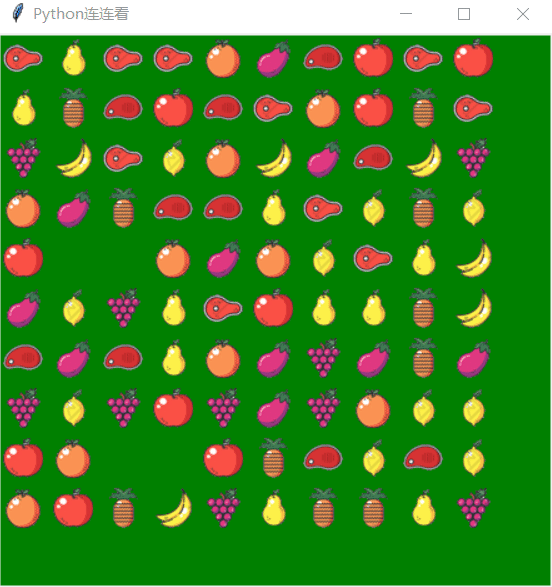
4. 示例源码
- from tkinter import *
- from tkinter.messagebox import *
- from threading import Timer
- import time
- import random
-
-
- class Point:
- # 点类
- def __init__(self, x, y):
- self.x = x
- self.y = y
-
-
- # --------------------------------------
-
-
- '''
- 判断选中的两个方块是否可以消除
- '''
-
-
- def IsLink(p1, p2):
- if lineCheck(p1, p2):
- return True
- if OneCornerLink(p1, p2): # 一个转弯(折点)的联通方式
- return True
- if TwoCornerLink(p1, p2): # 两个转弯(折点)的联通方式
- return True
- return False
-
-
- # ---------------------------
- def IsSame(p1, p2):
- if map[p1.x][p1.y] == map[p2.x][p2.y]:
- print("clicked at IsSame")
- return True
- return False
-
-
- def callback(event): # 鼠标左键事件代码
- global Select_first, p1, p2
- global firstSelectRectId, SecondSelectRectId
-
- # print ("clicked at", event.x, event.y,turn)
- x = (event.x) // 40 # 换算棋盘坐标
- y = (event.y) // 40
- print("clicked at", x, y)
-
- if map[x][y] == " ":
- showinfo(title="提示", message="此处无方块")
- else:
-
- if Select_first == False:
- p1 = Point(x, y)
- # 画选定(x1,y1)处的框线
- firstSelectRectId = cv.create_rectangle(x * 40, y * 40, x * 40 + 40, y * 40 + 40, width=2, outline="blue")
- Select_first = True
- else:
- p2 = Point(x, y)
- # 判断第二次点击的方块是否已被第一次点击选取,如果是则返回。
- if (p1.x == p2.x) and (p1.y == p2.y):
- return
- # 画选定(x2,y2)处的框线
- print('第二次点击的方块', x, y)
- # SecondSelectRectId=cv.create_rectangle(100,20,x*40+40,y*40+40,width=2,outline="yellow")
- SecondSelectRectId = cv.create_rectangle(x * 40, y * 40, x * 40 + 40, y * 40 + 40, width=2,
- outline="yellow")
- print('第二次点击的方块', SecondSelectRectId)
- cv.pack()
-
- # 判断是否连通
- if IsSame(p1, p2) and IsLink(p1, p2):
- print('连通', x, y)
- Select_first = False
- # 画选中方块之间连接线
- drawLinkLine(p1, p2)
- # clearTwoBlock()
- # time.sleep(0.6)
- # clearFlag=True
- t = Timer(timer_interval, delayrun) # 定时函数
- t.start()
-
-
- else: # 重新选定第一个方块
- # 清除第一个选定框线
- cv.delete(firstSelectRectId)
- cv.delete(SecondSelectRectId)
- # print('清除第一个选定框线')
- # firstSelectRectId=SecondSelectRectId
- # p1=Point(x,y) #设置重新选定第一个方块的坐标
- Select_first = False
-
-
- timer_interval = 0.3 # 0.3秒
-
-
- # --------------------------------------
- def delayrun():
- clearTwoBlock() # 清除连线及方块
-
-
- def clearTwoBlock(): # 清除连线及方块
- # 延时0.1秒
- # time.sleep(0.1)
- # 清除第一个选定框线
- cv.delete(firstSelectRectId)
- # 清除第2个选定框线
- cv.delete(SecondSelectRectId)
- # 清空记录方块的值
- map[p1.x][p1.y] = " "
- cv.delete(image_map[p1.x][p1.y])
- map[p2.x][p2.y] = " "
- cv.delete(image_map[p2.x][p2.y])
- Select_first = False
- undrawConnectLine() # 清除选中方块之间连接线
-
-
- def drawQiPan(): # 画棋盘
- for i in range(0, 15):
- cv.create_line(20, 20 + 40 * i, 580, 20 + 40 * i, width=2)
- for i in range(0, 15):
- cv.create_line(20 + 40 * i, 20, 20 + 40 * i, 580, width=2)
- cv.pack()
-
-
- def print_map(): # 输出map地图
- global image_map
- for x in range(0, Width): # 0--14
- for y in range(0, Height): # 0--14
- if (map[x][y] != ' '):
- img1 = imgs[int(map[x][y])]
- id = cv.create_image((x * 40 + 20, y * 40 + 20), image=img1)
- image_map[x][y] = id
- cv.pack()
- for y in range(0, Height): # 0--14
- for x in range(0, Width): # 0--14
- print(map[x][y], end=' ')
- print(",", y)
-
-
- '''
- * 同行同列情况消除方法 原理:如果两个相同的被消除元素之间的 空格数
- spaceCount等于他们的(行/列差-1)则 两者可以联通消除
- * x代表列,y代表行
- * param p1 第一个保存上次选中点坐标的点对象
- * param p2 第二个保存上次选中点坐标的点对象
- '''
-
-
- # 直接连通
- def lineCheck(p1, p2):
- absDistance = 0
- spaceCount = 0
- if (p1.x == p2.x or p1.y == p2.y): # 同行同列的情况吗?
- print("同行同列的情况------")
- # 同列的情况
- if (p1.x == p2.x and p1.y != p2.y):
- print("同列的情况")
- # 绝对距离(中间隔着的空格数)
- absDistance = abs(p1.y - p2.y) - 1
- # 正负值
- if p1.y - p2.y > 0:
- zf = -1
- else:
- zf = 1
- for i in range(1, absDistance + 1):
- if (map[p1.x][p1.y + i * zf] == " "):
- # 空格数加1
- spaceCount += 1
- else:
- break; # 遇到阻碍就不用再探测了
-
- # 同行的情况
- elif (p1.y == p2.y and p1.x != p2.x):
- print(" 同行的情况")
- absDistance = abs(p1.x - p2.x) - 1
- # 正负值
- if p1.x - p2.x > 0:
- zf = -1
- else:
- zf = 1
- for i in range(1, absDistance + 1):
- if (map[p1.x + i * zf][p1.y] == " "):
- # 空格数加1
- spaceCount += 1
- else:
- break; # 遇到阻碍就不用再探测了
- if (spaceCount == absDistance):
- # 可联通
- print(absDistance, spaceCount)
- print("行/列可直接联通")
- return True
- else:
- print("行/列不能消除!")
- return False
- else:
- # 不是同行同列的情况所以直接返回false
- return False;
-
- # --------------------------------------
-
-
- # 第二种,直角连通
- '''
- 直角连接,即X,Y坐标都不同的,可以用这个方法尝试连接
- param first:选中的第一个点
- param second:选中的第二个点
- '''
-
-
- def OneCornerLink(p1, p2):
- # 第一个直角检查点,如果这里为空则赋予相同值供检查
- checkP = Point(p1.x, p2.y)
- # 第二个直角检查点,如果这里为空则赋予相同值供检查
- checkP2 = Point(p2.x, p1.y);
- # 第一个直角点检测
- if (map[checkP.x][checkP.y] == " "):
- if (lineCheck(p1, checkP) and lineCheck(checkP, p2)):
- linePointStack.append(checkP)
- print("直角消除ok", checkP.x, checkP.y)
- return True
- # 第二个直角点检测
- if (map[checkP2.x][checkP2.y] == " "):
- if (lineCheck(p1, checkP2) and lineCheck(checkP2, p2)):
- linePointStack.append(checkP2)
- print("直角消除ok", checkP2.x, checkP2.y)
- return True
- print("不能直角消除")
- return False;
-
-
- # -----------------------------------------
- '''
- #第三种,双直角连通
- 双直角联通判定可分两步走:
- 1. 在p1点周围4个方向寻找空格checkP
- 2. 调用OneCornerLink(checkP, p2)
- 3. 即遍历 p1 4 个方向的空格,使之成为 checkP,然后调用 OneCornerLink(checkP,
- p2)判定是否为真,如果为真则可以双直角连同,否则当所有的空格都遍历完而没有找
- 到一个checkP使OneCornerLink(checkP, p2)为真,则两点不能连同
- 具体代码:
- 双直角连接方法
- @param p1 第一个点
- @param p2 第二个点
- '''
-
-
- def TwoCornerLink(p1, p2):
- checkP = Point(p1.x, p1.y)
- # 四向探测开始
- for i in range(0, 4):
- checkP.x = p1.x
- checkP.y = p1.y
- # 向下
- if (i == 3):
- checkP.y += 1
- while ((checkP.y < Height) and map[checkP.x][checkP.y] == " "):
- linePointStack.append(checkP)
- if (OneCornerLink(checkP, p2)):
- print("下探测OK")
- return True
- else:
- linePointStack.pop()
- checkP.y += 1
- print("ssss", checkP.y, Height - 1)
- # 补充两个折点都在游戏区域底侧外部
- if checkP.y == Height: # 出了底部,则仅需判断p2能否也达到底部边界
- z = Point(p2.x, Height - 1) # 底部边界点
- if lineCheck(z, p2): # 两个折点在区域外部的底侧
- linePointStack.append(Point(p1.x, Height))
- linePointStack.append(Point(p2.x, Height))
- print("下探测到游戏区域外部OK")
- return True
- # 向右
- elif (i == 2):
- checkP.x += 1
- while ((checkP.x < Width) and map[checkP.x][checkP.y] == " "):
- linePointStack.append(checkP)
- if (OneCornerLink(checkP, p2)):
- print("右探测OK")
- return True
- else:
- linePointStack.pop()
- checkP.x += 1
- # 补充两个折点都在游戏区域右侧外部
- if checkP.x == Width: # 出了右侧,则仅需判断p2能否也达到右部边界
- z = Point(Width - 1, p2.y) # 右部边界点
- if lineCheck(z, p2): # 两个折点在区域外部的底侧
- linePointStack.append(Point(Width, p1.y))
- linePointStack.append(Point(Width, p2.y))
- print("右探测到游戏区域外部OK")
- return True
- # 向左
- elif (i == 1):
- checkP.x -= 1
- while ((checkP.x >= 0) and map[checkP.x][checkP.y] == " "):
- linePointStack.append(checkP)
- if (OneCornerLink(checkP, p2)):
- print("左探测OK")
- return True
- else:
- linePointStack.pop()
- checkP.x -= 1
- # 向上
- elif (i == 0):
- checkP.y -= 1
- while ((checkP.y >= 0) and map[checkP.x][checkP.y] == " "):
- linePointStack.append(checkP)
- if (OneCornerLink(checkP, p2)):
- print("上探测OK")
- return True
- else:
- linePointStack.pop()
- checkP.y -= 1
-
- # 四个方向都寻完都没找到适合的checkP点
- print("两直角连接没找到适合的checkP点")
- return False;
-
-
- # ---------------------------
- # 画连接线
- def drawLinkLine(p1, p2):
- if (len(linePointStack) == 0):
- Line_id.append(drawLine(p1, p2))
- else:
- print(linePointStack, len(linePointStack))
- if (len(linePointStack) == 1):
- z = linePointStack.pop()
- print("一折连通点z", z.x, z.y)
- Line_id.append(drawLine(p1, z))
- Line_id.append(drawLine(p2, z))
- if (len(linePointStack) == 2):
- z1 = linePointStack.pop()
- print("2折连通点z1", z1.x, z1.y)
- Line_id.append(drawLine(p2, z1))
- z2 = linePointStack.pop()
- print("2折连通点z2", z2.x, z2.y)
- Line_id.append(drawLine(z1, z2))
- Line_id.append(drawLine(p1, z2))
-
-
- # 删除连接线
- def undrawConnectLine():
- while len(Line_id) > 0:
- idpop = Line_id.pop()
- cv.delete(idpop)
-
-
- def drawLine(p1, p2):
- print("drawLine p1,p2", p1.x, p1.y, p2.x, p2.y)
- # cv.create_line( 40+20, 40+20,200,200,width=5,fill='red')
- id = cv.create_line(p1.x * 40 + 20, p1.y * 40 + 20, p2.x * 40 + 20, p2.y * 40 + 20, width=5, fill='red')
- # cv.pack()
- return id
-
-
- # --------------------------------------
- def create_map(): # 产生map地图
- global map
- # 生成随机地图
- # 将所有匹配成对的动物物种放进一个临时的地图中
- tmpMap = []
- m = (Width) * (Height) // 10
- print('m=', m)
- for x in range(0, m):
- for i in range(0, 10): # 每种方块有10个
- tmpMap.append(x)
- random.shuffle(tmpMap)
- for x in range(0, Width): # 0--14
- for y in range(0, Height): # 0--14
- map[x][y] = tmpMap[x * Height + y]
-
-
- # --------------------------------------
- def find2Block(event): # 自动查找
- global firstSelectRectId, SecondSelectRectId
- m_nRoW = Height
- m_nCol = Width
- bFound = False;
- # 第一个方块从地图的0位置开始
- for i in range(0, m_nRoW * m_nCol):
- # 找到则跳出循环
- if (bFound):
- break
-
- # 算出对应的虚拟行列位置
- x1 = i % m_nCol
- y1 = i // m_nCol
- p1 = Point(x1, y1)
- # 无图案的方块跳过
- if (map[x1][y1] == ' '):
- continue
- # 第二个方块从前一个方块的后面开始
- for j in range(i + 1, m_nRoW * m_nCol):
- # 算出对应的虚拟行列位置
- x2 = j % m_nCol
- y2 = j // m_nCol
- p2 = Point(x2, y2)
- # 第二个方块不为空 且与第一个方块的动物相同
- if (map[x2][y2] != ' ' and IsSame(p1, p2)):
- # 判断是否可以连通
- if (IsLink(p1, p2)):
- bFound = True
- break
- # 找到后自动消除
- if (bFound): # p1(x1,y1)与p2(x2,y2)连通
- print('找到后', p1.x, p1.y, p2.x, p2.y)
- # 画选定(x1,y1)处的框线
- firstSelectRectId = cv.create_rectangle(x1 * 40, y1 * 40, x1 * 40 + 40, y1 * 40 + 40, width=2, outline="red")
- # 画选定(x2,y2)处的框线
- secondSelectRectId = cv.create_rectangle(x2 * 40, y2 * 40, x2 * 40 + 40, y2 * 40 + 40, width=2, outline="red")
- # t=Timer(timer_interval,delayrun)#定时函数
- # t.start()
-
- return bFound
-
-
- # 游戏主逻辑
- root = Tk()
- root.title("Python连连看 ")
- imgs = [PhotoImage(file='images\\bar_0' + str(i) + '.gif') for i in range(0, 10)] # 所有图标图案
- Select_first = False # 是否已经选中第一块
- firstSelectRectId = -1 # 被选中第一块地图对象
- SecondSelectRectId = -1 # 被选中第二块地图对象
- clearFlag = False
- linePointStack = []
- Line_id = []
- Height = 10
- Width = 10
- map = [[" " for y in range(Height)] for x in range(Width)]
- image_map = [[" " for y in range(Height)] for x in range(Width)]
- cv = Canvas(root, bg='green', width=440, height=440)
- # drawQiPan( )
- cv.bind("<Button-1>", callback) # 鼠标左键事件
- cv.bind("<Button-3>", find2Block) # 鼠标右键事件
- cv.pack()
- create_map() # 产生map地图
- print_map() # 打印map地图
- root.mainloop()

版权声明:本文为博主原创文章,遵循 CC 4.0 BY-SA 版权协议,转载请附上原文出处链接和本声明。本文链接:
https://blog.csdn.net/xw1680/article/details/116201057
推荐阅读 点击标题可跳转
Python之父推荐!《Python 3网络爬虫开发实战》第二版来了!文末送签名版!
【原创干货】6000字、22个案例详解Pandas数据分析/预处理时的实用技巧,超简单
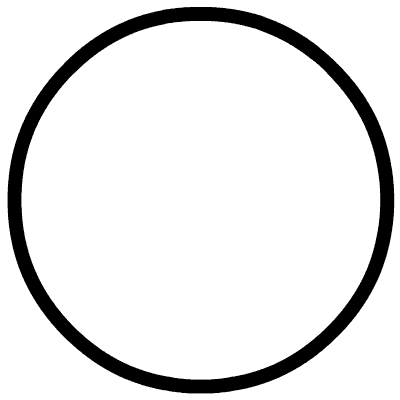
点击这里,阅读更多
Python
文章!



